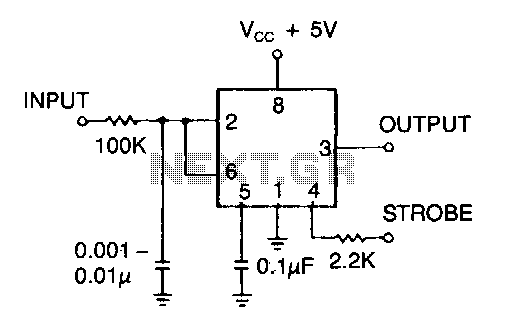
Low-cost-line-receiver

This timer serves as an effective line receiver for control applications that involve relatively slow electromechanical devices. It operates without the need for special drivers over single, unshielded lines.
The timer circuit is designed to facilitate communication between control systems and electromechanical devices such as relays and solenoids, which typically require slower response times. Its functionality is particularly beneficial in environments where signal integrity must be maintained over unshielded lines, thus reducing the need for additional components that might complicate the design or increase costs.
The timer can be implemented using a variety of integrated circuits (ICs) that are capable of timing functions. Commonly, a 555 timer IC may be employed in monostable or astable configurations, depending on the specific timing requirements of the application. In a monostable setup, the timer will generate a single output pulse in response to an input trigger, which is ideal for applications requiring a defined delay before activating an electromechanical device. In contrast, an astable configuration allows for continuous oscillation, producing a square wave output that can be useful for generating clock signals or modulating control signals.
The design should include appropriate resistors and capacitors to set the timing intervals, which can be calculated based on the formula provided in the IC's datasheet. Additionally, consideration must be given to the power supply requirements and the input/output voltage levels to ensure compatibility with the connected devices.
For applications that involve longer distances or potential interference, it may be prudent to incorporate filtering or buffering components to enhance signal integrity. Overall, this timer circuit provides a robust solution for control applications involving electromechanical devices, ensuring reliable operation without the complexity of specialized drivers.This timer makes an excellent line receiver for control applications involving relatively slow electromechanical devices. It can work without special drivers over single, unshielded lines.
The timer circuit is designed to facilitate communication between control systems and electromechanical devices such as relays and solenoids, which typically require slower response times. Its functionality is particularly beneficial in environments where signal integrity must be maintained over unshielded lines, thus reducing the need for additional components that might complicate the design or increase costs.
The timer can be implemented using a variety of integrated circuits (ICs) that are capable of timing functions. Commonly, a 555 timer IC may be employed in monostable or astable configurations, depending on the specific timing requirements of the application. In a monostable setup, the timer will generate a single output pulse in response to an input trigger, which is ideal for applications requiring a defined delay before activating an electromechanical device. In contrast, an astable configuration allows for continuous oscillation, producing a square wave output that can be useful for generating clock signals or modulating control signals.
The design should include appropriate resistors and capacitors to set the timing intervals, which can be calculated based on the formula provided in the IC's datasheet. Additionally, consideration must be given to the power supply requirements and the input/output voltage levels to ensure compatibility with the connected devices.
For applications that involve longer distances or potential interference, it may be prudent to incorporate filtering or buffering components to enhance signal integrity. Overall, this timer circuit provides a robust solution for control applications involving electromechanical devices, ensuring reliable operation without the complexity of specialized drivers.This timer makes an excellent line receiver for control applications involving relatively slow electromechanical devices. It can work without special drivers over single, unshielded lines.